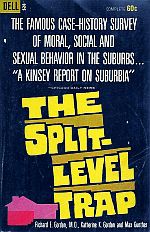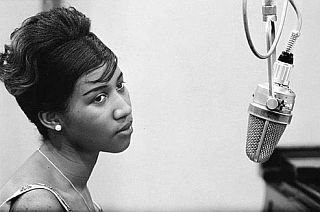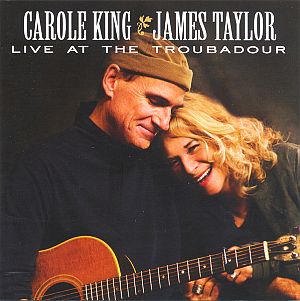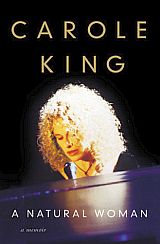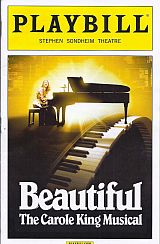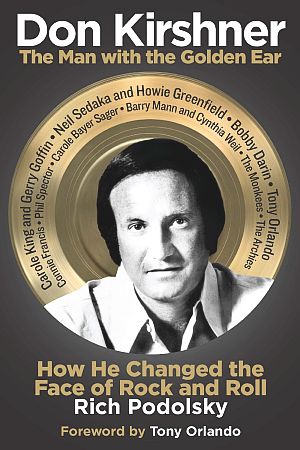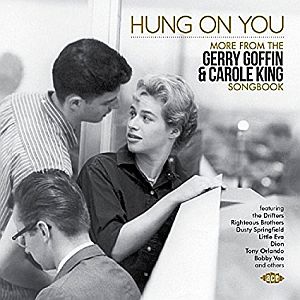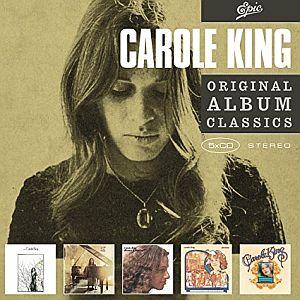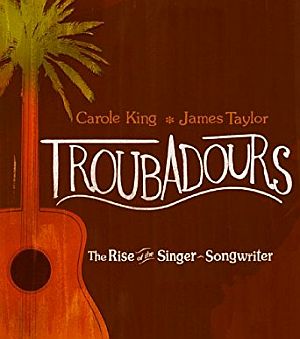For a time in the 1950s-1960s era, Carole King and Gerry Goffin, pictured below, made beautiful music together, both in their love affair and for the millions who listened to the songs they wrote. They became, at a young age, one of America’s most creative and productive songwriting teams. They rose to fame working for the fabled New York City / Brill Building song publisher, Aldon Music. Their story is one of great accomplishment, though touched by personal sorrow, love undone, and rocky travels ahead for each. What follows here is some of that history and cultural context.

1959: In a photo that suggests an air of youthful confidence, young lovers Carole King & Gerry Goffin are about to hit the big time with a string of pop music hits. But their union would not survive the shoals of 1960s’ drugs and entertainment-world temptations.
Gerry Goffin and Carole King were each born and raised in the boroughs of New York City. Gerry was born in Brooklyn, though later moving to Queens after his parents divorced when he was five. Carole Klein – later taking the name Carole King in high school – was born in Manhattan, daughter of a firefighter and school teacher. She would be raised in Brooklyn and taught piano by her mother at an early age. As a boy, Gerry had been exposed to show tune music at home, and growing up, he also “played a game with words in my head,” though without music, foreshadowing a talent that would serve him well a few years later. After graduating from Brooklyn Technical High School, Gerry enlisted in the Marine Corps Reserve. He then spent a year at the U.S. Naval Academy, Class of 1961, but resigned from the Navy to study chemistry at Queens College.
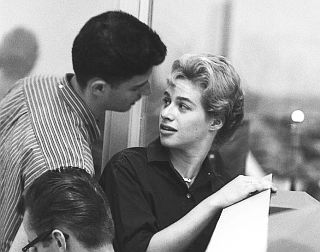 Gerry & Carole at work in their early days at Aldon Music. |
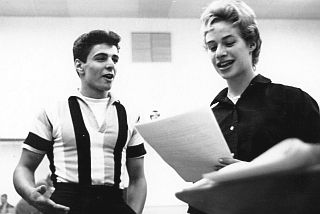 1959: Carole King and singer Johnny Restivo between takes in New York recording studio. |
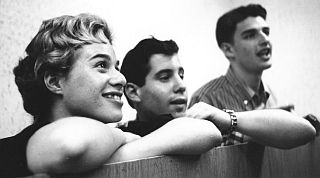 1959, New York: Carole King, Paul Simon, and Gerry Goffin listening to a playback of some music they worked on. |
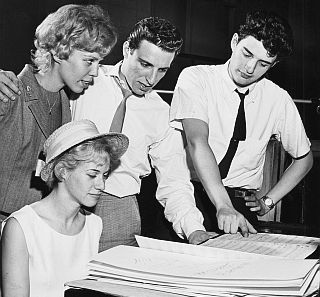 Early 1960s. Carole King at piano, with fellow Brill Building song writers Barry Mann and Cynthia Weil behind her, and husband/partner, Gerry Goffin, far right. |
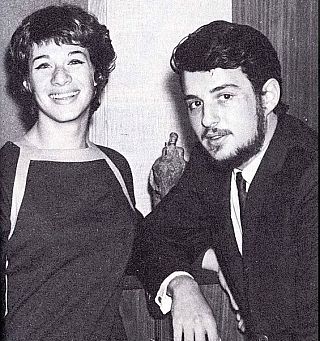 Carole King & Gerry Goffin, somewhat later 1960s. |
Carole went to public high school in Brooklyn and as a teen had attended Alan Freed Paramount Theater rock `n roll shows in New York, where she had been moved by the music and performers. In high school she formed a band briefly and made demo records with her friend, Paul Simon. Carole sold her first composition in Manhattan for $25 when she was 16. But in 1958, Carole King met Gerry Goffin at Queens College.
“She was interested in writing rock’n’roll, and I was interested in writing this Broadway play [a musical about beatniks],” Goffin would later recall for Vanity Fair. “So we had an agreement where she would write [music] to the play if I would write [lyrics] to some of her rock ‘n roll melodies…” Gerry eventually gave up on his play, as the pair decided to focus on writing rock ‘n roll tunes. And along the way, they fell in love.
Neil Sedaka, who had dated King in high school, had a hit song in 1959 titled “Oh! Carol.” Goffin took the tune and wrote a playful response to it titled, “Oh! Neil,” which King recorded and released as a single. She and Gerry also wrote the B-side song on that single, but neither song was a success.
Their personal relationship, however, was going strong. In August 1959, Carole and Gerry were married in a Jewish ceremony on Long Island after Carol had become pregnant. He was 20 and she was 17. They both quit college and took daytime jobs; Goffin working as an assistant chemist and King as a secretary. They wrote songs together in the evening.
It was about then that Don Kirshner at Aldon Music in Manhattan hired them both to write songs professionally. Carole’s friend, Neil Sedaka, had worked there as well.
Carole would later tell a New York Times reporter of how they worked at Aldon Music:
“…We each had a little cubby hole with just enough room for a piano, a bench and maybe a chair for the lyricist — if you were lucky. You’d sit there and write and you could hear someone in the next cubby hole composing some song exactly like yours…
“The pressure… was really terrific, because Donny [Kirshner, of Aldon] would play one songwriter against an other. He’d say ‘We need a latest smash hit,’ and we’d all go back and write a song and the next day we’d each audition for Bobby Vee’s producer. ‘Take Good Care of My Baby,’ one of our biggest hits, came about that way.”
Initially, Gerry and Carole both worked with other composers and writers. And in one case they would establish a long-lasting friendship, though competitors in songwriting, with Barry Mann and Cynthia Weil, another husband-and-wife team at Aldon.
Still, before long, Carole King and Gerry Goffin soon established themselves as a successful team, she crafting the music and he the lyrics. Their big breakthrough came with the 1960 song, “Will You Love Me Tomorrow?” It was in 1960, not long after the couple had their first child. They were then based at Aldon Music at the 1650 Broadway, across from the famed Brill Building, and they also worked at home.
Making The Hit
As Carole would later recall in her book, A Natural Woman, the hottest girl group in the country at that time were the Shirelles, four black teenagers just a few years out of Passaic High School in New Jersey – Shirley Owens, Doris Coley, Addie Harris, and Beverly Lee. They had just broken out with the hit song “Tonight’s The Night.” Don Kirshner and Aldon Music wanted the follow-up song to that hit, whatever it might be, and he pushed his writers and composers to come up with it.
Carole King began working from piano on music and melody, using “There Goes My Baby” as a model. Soon, she had worked up a rough demo. But when the Shirelles first heard Carole’s demo, they found it sounded “like a country-and-Western song,” and didn’t like it. So a strings section for the song was suggested, which Carole then planned to incorporate into her melody. On the strings arrangement, Carole later acknowledged in her book, this was her first: “I had never before composed a string arrangement.”
|
“Will You Love Me” Tonight you’re mine completely Is this a lasting treasure Tonight with words unspoken I’d like to know that your love So tell me now, and I won’t ask again |
One morning after she dropped off her daughter at her grandmother’s, King traveled to the offices and studio of Scepter Records, the Shirelles’ record label. There she recorded the rhythm track, which took less than an hour.
“…Then the string players arrived,” she would later recount in her book. “The first time I heard the cellos play the rhythmic figure at the beginning of ‘Will You Love Me Tomorrow,’ I was euphoric. Some composers literally hear the sounds in their head as they write; I had to wait until a session to hear what I wrote. As the musicians began to play the parts I had written for ‘Will You Love Me Tomorrow,’ I became giddy with excitement. I was 18.”
Music Player
“Will You Love Me Tomorrow?”
The Shirelles: 1960-61
But the words for this song were also key – and that was Gerry’s department. Goffin came home from a night bowling with his buddies to find a message from Carole on the tape recorder, asking him to write lyrics for the music she had composed for the Shirelles, as Don Kershner was hot to get the tune locked up. Goffin would later say that the lyrics came easily to him.
Hiram Lee, writing some years later on the Goffin-King effect in this song, observes:
…On this pop classic, King’s fragile melody seems to rise nervously from its bed of chords as if she were raising a question she is afraid to ask. To this, Goffin’s lyrics add: “Tonight you’re mine completely/You give your love so sweetly/Tonight the light of love is in your eyes/But will you love me tomorrow?”
As was often the case, Goffin’s words seemed to marry so exactly to King’s melodic line that it was difficult to imagine the two having been written separately.
Yet others would marvel at how Gerry, a guy, could reach into a woman’s thoughts and emotions and express her feelings, as he did in this song, and would do in other songs to come. As former Shirelle, Beverely Lee, offered of the “Will-You-Love-Me-Tomorrow” lyrics in a May 2018 New Yorker story:
“Now that I’m older, I listen to the lyrics. Knowing what’s going on — as women, you have a right to ask: Are you going to still love me if I am your loved one? Are you just going to love me for the moment and leave me? Is this a lasting treasure or just a moment’s pleasure? Can I read the magic of your sighs? Will you love me tomorrow? That tells it all. Are you going to be for real with me, or are you just playing with me and my emotions? What am I worth to you? That’s what it’s saying.”
When the final Goffin-King package came together for “Will You Love Me Tomorrow,” they had the follow-up Kirshner wanted, and then some. “…Tomorrow” became a giant hit, reaching No. 1 on the Billboard Hot 100 in January 1961 – the first song by a female group to reach No. 1 on the pop charts since the McGuire Sisters in 1958, and first ever for a black female group.
‘Bye-Bye Day Job!’
Gerry and Carole, a young married couple then living in a Brooklyn basement apartment, were still working other day jobs while they wrote their music. But the hit record they had just composed would change all that, as Carole recalled: “When ‘Will You Love Me Tomorrow?’ sold a million [copies], we went: ‘bye-bye day job!’” Gerry Goffin remembered that day too, as he was still working his chemical company day job: “Carole and [Don Kirshner of Aldon Music] arrived in Donny’s limousine at the chem factory and told me I didn’t have to work anymore. And he gave us a $10,000 advance and we got credit cards, and I’ve never had to do an honest day’s work since.”
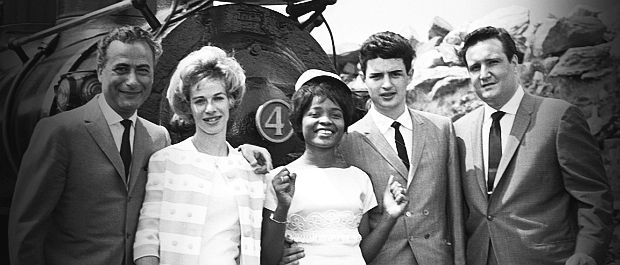
Later 1963 photo for the hit song, “The Loco-Motion,” from left: Aldon Music producer Al Nevins; composer, Carole King,; singer, Little Eva Boyd; songwriter, Gerry Goffin; and Aldon Music producer, Don Kirshner. Click to visit 'Loco-Motion' story.
The Shirelles’ hit was a turning point for the Goffin-King partnership – and more hits kept coming. In 1961 they did “Take Good Care of My Baby,” a No. 1 hit for singer Bobby Vee and “Some Kind of Wonderful,” a Top 40 hit for The Drifters. Then came “The Loco-Motion” in 1962, another No. 1 hit with their former baby sitter, Eva Boyd, who became “Little Eva.” (see separate story at this website on the history and success of this song). They also wrote and composed “Up On The Roof” in 1962, a No. 5 hit for The Drifters.
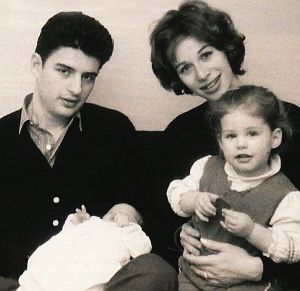
Early 1960s photo of the growing Goffin-King family.
Carole and Gerry had two small children at the time, and Carole was not interested in traveling to promote the song. However, she was persuaded by Kirshner and Gerry to appear on Dick Clark’s American Bandstand, where she performed the song in lyp-sync mode as was the custom there, but received a low score in a Bandstand “rate-a-record” session.
Still, the song peaked at No 22 on the Billboard charts in September 1962, and also rose to No. 3 on the U.K. charts. Yet, according to some accounts, Carole was discouraged from doing further recordings herself at this point by Gerry, who preferred her to focus on the composing part of their partnership. And according to Carole herself, she then lacked the confidence to write lyrics. But that would change.
|
Goffin-King Music “Will You Love Me Tomorrow” |
Over the next several years, through the mid- and late 1960s, more hits came for Gerry Goffin and Carole King, including more No. 1 hits, and others charting in the Top Ten and Top 40. In all, between 1960 and 1968, the Goffin-King team would write more than 50 Top 40 hits together – among those not already mentioned: “Crying in the Rain,” “Some Kind of Wonderful,” “Take Good Care of My Baby,” “Pleasant Valley Sunday,” “Natural Woman,” and others.
They had particularly good fortune with the black girl group sound; a winning formula in the early 1960s. Among these girl group successes were The Cookies, then consisting of Dorothy Jones, Earl-Jean McCrea, and Margaret Ross. In 1962, the Cookies had a Top 20 hit with the Goffin-King song “Chains.”
Music Player
“Chains”
The Cookies: 1962
They scored a second somewhat bigger hit in 1963 with the Goffin-King song, “Don’t Say Nothin’ Bad (About My Baby)”, which peaked at No.3 on the Billboard R&B chart and No.7 on the Billboard pop chart. But it was the earlier Cookies hit, “Chains” that brought the group and Goffin-King some unexpected attention.
The Beatles, who were then coming on the music scene in a big way, had covered “Chains” for their first British LP. The Beatles had recorded it on February 11, 1963 and released it on their debut album, Please Please Me, on March 22, 1963. In fact, John Lennon was quoted as saying about this time that he wanted Paul McCartney and himself to become “the Goffin-King of England.” This helped give the Goffin-King songwriting team more notice, and demand for their talents rose.
Gerry Goffin, meanwhile, went on the road with The Cookies, leaving Carole at home with the two kids. And before long, he was having an affair with one of the Cookies, Earl-Jean McCrea.
By early 1964 it was apparent that Earl-Jean was pregnant and Gerry was the father. The baby was born in July 1964. Gerry had been restless and unsettled, and he had told Carole about his dalliances, not wanting to lie to her. But the McCrea affair was a sign of troubles to come.
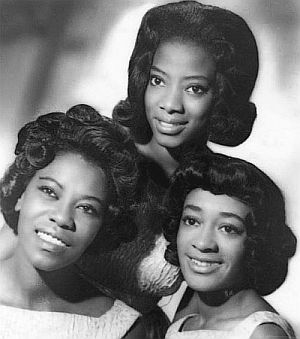
The Cookies, mid-1960s: Dorothy Jones, Earl-Jean McCrea, and Margaret Ross. Dimension Records. Click for CD.
As Gerry would later explain in a Vanity Fair interview: “I wanted to be a hippie—grew my hair long—and Carole did it modestly… And then I started taking LSD and mescaline. And Carole and I began to grow apart because she felt that she had to say things herself. She had to be her own lyricist.”
McCrea, meanwhile, would leave the Cookies and sign with the Colpix record label, where she recorded the Goffin-King song, “I’m Into Something Good,” which hit No. 38 on the Billboard Hot 100 in 1964. However, this Goffin-King tune became a bigger No. 1 U.K. hit for the British group, Herman’s Hermits, that same year.
Suburban Angst
Through the mid-to-late 1960s, the Goffin-King songwriting continued, though now under a good deal of strain given their personal circumstances, but still staying together as a couple. Adding to this strain, no doubt, was the move they made in 1965 to the New Jersey suburb of West Orange. Carole had wanted to make the move, but now there was an added complication. With financial help from Goffin-King song-writing royalties, Earl-Jean McCrea would move into a nearby home in the same suburb.
|
“Pleasant Valley The local rock group down the street Another pleasant valley Sunday See Mrs. Gray, she’s proud today Another pleasant valley Sunday Creature comfort goals, Ta ta ta ta, ta ta ta ta Another pleasant valley Sunday Another pleasant valley Sunday |
Meanwhile, Gerry was not a big fan of the suburbs to begin with, and this would be revealed in the lyrics he wrote for the 1967 song that he and Carole composed for The Monkees – “Pleasant Valley Sunday”, a No. 3 hit in July 1967. The song was pure satire and social commentary on life in suburbia. The inspiration for the song’s title, in fact, derived from a street in West Orange near to where Gerry and Carole were living, named Pleasant Valley Way.
Music Player
“Pleasant Valley Sunday”
The Monkees-1967
At the time Goffin and King wrote “Pleasant Valley Sunday,” suburbia was already topical, with a growing collection of popular books and academic literature, some critical, some not.
Titles dating from the mid-1950s and early 1960s took on one or more aspects of the suburban experience. Among these, for example, were, A.C. Spectorsky’s The Exurbanites of 1955, and Split-Level Trap of 1961, by Richard and Katherine Gordon. More sympathetic portrayals came with William H. Whyte’s The Organization Man of 1957, examining Park Forest, Illinois, and Herbert Gans’ 1965 sociological study of Levittown, New Jersey, The Levittowners.Also in music at that time, there was the 1962 song, “Little Boxes,” written and composed by folk singer-songwriter-activist Malvina Reynolds, a song noted for its line mocking the sameness of suburban tract housing as “little boxes” made of “ticky-tacky.” That song became a 1963 hit for folk singer Pete Seeger.
In any case, Goffin and King’s “Pleasant Valley Sunday” captured a bit of the critical vibe at the time for suburbia in the 1960s. The song stayed in the Top 40 for most of that summer and was also featured during the Monkees’ television series that year.
Gerry, meanwhile, was feeling especially isolated in suburbia and was having bigger problems. He was taking LSD and dealing with a crumbling marriage. King would later write in her book that Goffin suffered from mental illness following his use of LSD. He would be diagnosed with manic depression, and was hospitalized for a time. He eventually underwent treatment with lithium and electroshock therapy. He and King would separate in 1967 and divorce in 1968.
Goffin and King, like the rest of America, had gone through some perilous times in the 1961-67 period. The country was still digesting the November 1963 assassination of its promising young president, John F. Kennedy. A certain innocence had died then as well. A rising civil rights struggle was then underway: the Freedom Rides (1961), the March on Washington (1963) and the “Bloody Sunday” beatings of marchers in Selma, Alabama (1965) had all occurred, among others. Anti-Vietnam War sentiment was increasing at home as U.S. troop levels rose and more Americans were being killed. On the music scene, in addition to the Beatles arrival in 1964 and the subsequent “British invasion,” there was also competition from Berry Gordy’s Motown music center in Detroit, as well as the onset of new folk and protest music. Bob Dylan, who had begun performing in Greenwich Village clubs in 1961, released his first album with Columbia in March 1962. And finally, Don Kirchner sold Aldon Music to Columbia Screen Gems in 1963 for $3 million and had begun packaging his songwriters’ music under the new ownership for use in TV, film, and Hollywood – of which the Monkees were one example.
Hit for Aretha
Still, in the midst of the cultural changes and industry upheaval, and the Goffin-King personal struggles, the pair would manage a few more hit songs. One of these is perhaps Gerry Goffin’s tour de force — “A Natural Woman,” or more correctly, “You Make Me Feel Like a Natural Woman.”
The song became a classic 1967 hit for Aretha Franklin. It’s about a woman who is somewhat down and out, doubting herself, until a new love appears to lift her to a new beginning.
Although written by Goffin and King, the song’s title at least was inspired by Atlantic Records co-owner and producer Jerry Wexler. As recounted in his autobiography, Wexler, a student of African-American musical culture, had been mulling over the concept of the “natural man,” when he drove by Carole King on a New York sidewalk, shouting out to her that he wanted a “natural woman” song for Aretha Franklin’s next album. Goffin and King delivered in short order – and they would also give Wexler a co-writing credit for his part in their song.
|
“…A Natural Woman” Looking out on the morning rain ‘Cause you make me feel, When my soul was in the lost and found ‘Cause you make me feel, Oh, baby, what you’ve done to me You make me feel, You make me feel You make me feel Songwriters: Goffin / King / Wexler |
Yet the lyrics that Goffin would write for this song – powerfully delivered in performance by Aretha Franklin (and a few years later, also by Carole King) – continue to amaze critics to this day for Goffin’s ability to plumb the depths of female emotion. Goffin’s daughter for one, Sherry, herself a musician, would say on camera during a 2017 TV special, that lines from that song, such as – “When my soul was in the lost and found / You came along to claim it,” among others – were pretty amazing. Gerry Goffin had a gift that way.
Music Player
“…A Natural Woman”
Aretha Franklin-1967
“…Natural Woman” is also about spiritual satisfaction from the female perspective: “Oh, baby, what you’ve done to me / You make me feel so good inside.”
The Aretha Franklin version of the song was released in September 1967 and would peak at No. 8 on the Billboard Hot 100 chart, and No. 2 on the Billboard R & B chart
Yet, within a year of this single reaching the U.S. Top 10, the Goffin-King partnership was over. Both Carole and Gerry would move to California, where their careers would take new turns.
Carole’s Rise
Carole King’s move to Laurel Canyon in Los Angeles – then a haven for up-and-coming singer-songwriters – would prove beneficial, but not right away. Earlier, she had met James Taylor, who had encouraged her to begin solo recording and performing.
After a false start or two, and a middling debut album, Writer, King would find her footing in a big way in 1971 with her second solo album, Tapestry. That album proved to be a blockbuster, topping the U.S. album chart for 15 weeks and remaining on the charts for more than six years. Tapestry first charged onto the charts April 10, 1971, staying there for 302 consecutive weeks until January 15, 1977. Then it returned to the chart twice — in 2010 and 2016. Tapestry’s record was finally eclipsed by Adele’s album, 21, which logged its 319th week on the Billboard 200 album chart dated April 15, 2017.
Carole King proved herself a capable lyricist on Tapestry, crafting a series of new songs for the album, including: “So Far Away,” “I Feel the Earth Move,” “You’ve Got a Friend.” and “It’s Too Late,” this last song, a Billboard No.1 hit. She would even garner praise from former partner Gerry Goffin for the album: “It was completely original, and Carole really showed me up as a lyricist….”
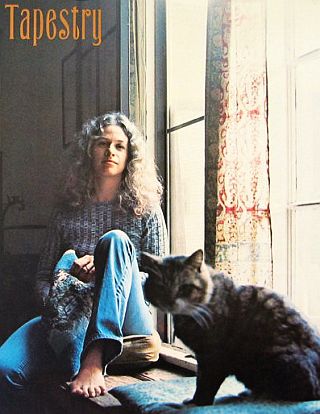
A portion of the cover art from Carole King's 1971 album, 'Tapestry," with Carole & cat in view. Click for Amazon link.
King reinterpreted these older Goffin-King tunes in her own style and voice. Her rendition of “Will You Love Me Tomorrow?,” for example, is far sadder and perhaps a bit wiser than the Shirelles’ version. Or as another observer put it, the slower version showed that the lyrics worked just as poignantly for a housewife stuck in an unstable marriage as they did for an innocent teenager pondering her first love. Delivery and performance of this song matters as well, as historian and writer Kirk Silsbee has observed: “The Shirelles sang ‘Will You Love Me Tomorrow’ like girls. Carole sang it as a woman” — each, however, appropriate for their times.
Women of all ages flocked to Tapestry. The mix of material King used on Tapestry struck a chord with women all over the world.
“Carole spoke from her heart, and she happened to be in tune with the mass psyche,” said her old Brill Building friend and fellow songwriter, Cynthia Weil. “People were looking for a message, and she came to them with… exactly what they were looking for.” Tapestry sold more than 15 million copies over the decades and became a critical influence on other artists.
The album also garnered four Grammy Awards for King: Album of the Year; Song of the Year (“You’ve Got a Friend”); Record of the Year (“It’s Too Late,” lyrics by Toni Stern); and Best Pop Vocal Performance, Female. Tapestry would help propel King to becoming one of America’s most beloved singer/songwriters.
Following Tapestry, Carole King had an incredible run of additional hit albums in the 1970s: Music (No. 1, Dec 1971); Rhymes and Reasons (No. 2, Nov 1972); Fantasy (No. 6, June 1973); Wrap Around Joy (No. 1, Sept 1974); Thoroughbred (No. 3, 1976 ); and Simple Things (No. 17, July 1977). Along the way, there was also touring, and a few notable homecomings, among these, her Carnegie Hall Concert of June 18, 1971, which was her first concert performance in front of an audience, and a free concert she gave in Central Park on May 26, 1973 made the front page of the next day’s Sunday New York Times with the headline: “Carole King Draws 70,000 to Central Park.”
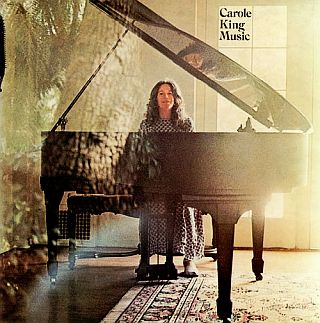
King’s 2nd album of 1971, “Music,” released Dec 9th, entered the charts at No. 8, reportedly selling 1.3 million copies the first day of its release, reaching No. 1 on Jan 1, 1972. Click for CD.
By virtue of her 1970s success, Carole King was becoming a wealthy woman. Tapestry alone yielded an estimated $10.7 million in earnings in 1971. She also had estimated earnings of $500,000 or more per album for the albums she produced in 1972, 1973, 1974, 1976 and 1977.
And over the next 30 years, there would be additional income generated by her continuing work, as well as a healthy stream of songwriting royalties from the Goffin-King back-catalog.
But during the late 1970s, King would move to Idaho and later buy a 128-acre ranch there, inspiring her environmental activism, including testimony some years later in Congress for protecting the northern Rocky Mountains ecosystem. King would also own other real estate, including a Hollywood Hills West home and an ocean-side home in Malibu, California, the latter acquired in 2003 for $1 million.
However, in her personal relationships following Gerry, Carole King traveled a difficult road. A second marriage to bass-player Charlie Larkey, with whom she had two children, would end after some years in 1976. Her third husband, musician Rick Evers, reported by Carole to have been abusive, died of a heroin overdose in 1978. A fourth marriage to Idaho rancher Rick Sorenson would end in divorce in 1989. Some who have written about King’s life, speculate that part of the reason for her failed relationships lay in her successive husbands’ failures to accept her achievements and celebrity.
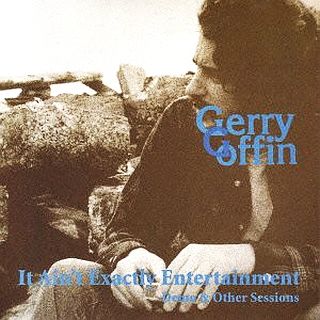
One version of a release from Gerry Coffin's 1973 album, "It Ain't Exactly Entertainment'.
Gerry Goffin, meanwhile, had continued success in his music career as well, though not on the scale that Carole King had. In 1973, he tried his hand at recording with a solo album, It Ain’t Exactly Entertainment, but it was not successful. This album was part social protest, as Goffin, an admirer of Bob Dylan, was feeling the social and political turmoil of those times. One of the songs on the album, “Honorable Peace,” was an anti-war song, aimed at the Vietnam War, by then a major point of social unrest.
But in the music business, songwriting collaboration was still Gerry Goffin’s strong suit, as he had collaborated with other songwriters in addition to Carole from his earliest years. And now he continued to do so, with partners such as Barry Mann, Jack Keller, Russ Titelman, Wes Farrell, Barry Goldberg and Michael Masser.
In 1975, Goffin and Michael Masser earned an Academy Award nomination for the “Theme From Mahogany (Do You Know Where You’re Going To?),” a No. 1 hit for Diana Ross from that movie. Goffin and Masser also received a Golden Globe nomination for “So Sad the Song,” from the 1976 Gladys Knight film, Pipe Dreams. They also wrote “Tonight, I Celebrate My Love” a 1983 duet hit by Peabo Bryson and Roberta Flack. In 1985, the Goffin-Masser R&B ballad, “Saving All My Love for You,” became Whitney Houston’s first No. 1 hit and Grammy winner. And in 1989, the Goffin/Masser/Preston Glass tune, “Miss You Like Crazy,” became a major hit for Natalie Cole, reaching No 7 of the Billboard chart, and No. 1 on both the R&B and adult contemporary charts, as well as No. 2 on the U.K. singles chart.
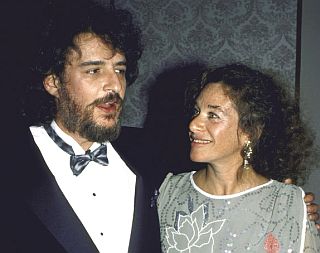
March 1987. Gerry Goffin and Carole King at their induction into the Songwriters Hall of Fame.
As Carole King and Gerry Goffin made their way through their respective separate careers, there was no escaping their earlier joint successes and history together – with all its glories and perhaps a few regrets. They had etched themselves into the American cultural tableau with their music making, and it was not letting go. If anything, their joint body of work was burnishing itself into rock music history more permanently.
By the mid-1980s, the legacy of their earlier Brill Building work, now more than 20 years old, was faring well with the test of time and in the judgement of their peers. In March 1987, Gerry and Carole were among those lauded for their work, along with seven others – including their former Brill Building colleagues, Barry Mann and Cynthia Weil – who were inducted into the Songwriters Hall of Fame, an arm of the National Academy of Popular Music. Three years later, in 1990, they were again jointly honored for their songwriting, this time inducted into the Rock ’n Roll Hall of Fame.

1990: Carole King and Gerry Goffin at their Rock 'n Roll Hall of Fame induction.
As songwriters, Gerry and Carole stand as a great bridge between the Brill Building styles of the late 1950s and the early 1960s and the modern rock era. And the fact is, they started looking forward with their very first hit. In 1961, they wrote a little song called “Will You Still Love Me Tomorrow?” It was the first great ‘60s record to be written from a woman’s point of view. It was a first great ballad directed toward a new generation that would soon be labeled “baby boomers.” And for some of the people in this very room, it was the first song they slow-danced too, made out too, and made love to. It was perhaps the first ’60s song about which you and your girlfriend or boyfriend said, “that’s our song.” And by the way, because it meant so much to so many, it is a song and a record – beautifully sung by the Shirelles – that will live on well into the next century. In 1962, the Drifters recorded their sublime “Up on the Roof,” a song that expressed the sensibility that a few years later would be called “60s idealism.” And in 1963 Gerry and Carole extended that idealism with a romantically eloquent “One Fine Day.” And then in 1965 they put themselves at the center of one of rock’s most vital developments – the Phil Spector-Righteous Brothers collaborations. One of the two songs they wrote with Phil was the classic, “Just Once in My Life,” and the other, is one of those great lost masterpieces due for rediscovery in the 1990s, a great song called “Hung on You.” By the time they wrote “Don’t Bring Me Down” for the Animals and “Goin Back” for the Byrds they helped to start an approach that would effect every sing-songwriter to come after them. And in a nice epiphany, in 1967, they closed a cycle they began with “Will You Still Love Me Tomorrow?,” when they wrote, “You Make Me Feel Like A Natural Woman” for Aretha Franklin. But by then, they had given us more that we could ever give back… Gerry Goffin and Carole King – two of rock’s great writers!

Gerry Goffin's "Back Room Blood" album of 1996, motivated by a conservative wave in Congress, with some Dylan input, but not successful. Click for CD.
Later Careers
Goffin and King, meanwhile, continued their careers through the 1990s and beyond. In 1996, Goffin co-wrote three songs for the soundtrack to Grace of My Heart, a film with a principal character modeled on Carole King.
That year, Goffin also took another stab at solo recording, releasing the album Back Room Blood, inspired by his politics and anger over conservative gains in the 1994 congressional elections. The album was mostly co-written with Barry Goldberg, but included two songs co-written with Bob Dylan.
At the time, Goffin also told a reporter at Billboard magazine: “I depend mostly on my back catalog… Actually, I could afford to retire, but I would go crazy…” Compositions from Goffin’s catalog at the time, in fact, appeared on the Beatles’ Live At The BBC album (1994), the Forest Gump film soundtrack (1994), and Carole King’s Tapesty Revisited album (1995).
Gerry Goffin, however, was also still dealing with his past marriage to Carole King, noting in one 1996 interview with United Press International: “Carole loved me for what I was… I’ve had a lot of guilt [over his role in that marriage]. It’s been almost 30 years, and I’m finally feeling expurgated…. I feel like I’ve worked it off, but maybe you never work it off.”
Gerry, like Carole, had married again, three more times in fact. In the early 1970s, he married Barbara Behling and they had a son in 1976. After that marriage ended later that decade, Goffin married songwriter Ellen Minasian in the 1980s and they had a daughter in 1984. Following a divorce in that union, Goffin married for a final time to actress Michele Conaway in 1995.Carole King, meanwhile, continued her busy career. In 1992, she wrote and performed the song “Now and Forever,” for the film, A League of Their Own, a song that received a Grammy nomination.
In 1997, she recorded backing vocals for Celine Dion’s song, “The Reason.” In 2001, after an eight-year break from studio recording, she released the album, Love Makes the World.
Another album, The Living Room Tour, was released in 2005, consisting mostly of live versions of her Tapestry songs. This album debuted at No. 17 in the U.S., becoming King’s highest-charting album since 1977, spurred, in part, by TV ads and Starbucks marketing. For the week of July 18, 2005 it was the No.1 album on Amazon.com.
In 2007 King and James Taylor performed six Troubadour club anniversary shows – as she and Taylor had performed at that famous Los Angeles night club in 1970. These Troubadour shows would inspire the Troubadour Reunion Tour with King and Taylor, which ran globally from March through May 2010, with 58 shows selling more than 700,000 tickets and grossing about $60 million, making it one of that year’s most successful tours. A King-Taylor Live at the Troubadour album was also released, which debuted at No. 4 on Billboard Album Chart that year.
In 2012, King published her memoir, A Natural Woman, which became a national bestseller. The next year, she became the fifth recipient and the first woman to receive the Gershwin Prize for popular song from the Library of Congress. President and Mrs. Barack Obama hosted the award concert at the White House on May 22, 2013, with the President presenting the prize and reading the citation.
In February 2013, she received a Grammy Lifetime Achievement award. And in January 2014, a Broadway musical covering her life – including the Goffin years – titled, Beautiful – The Carole King Musical, opened in New York. It would go on to great success, wining two Tony Awards, and after its London run, two Olivier Awards. King had been apprehensive about the show’s dredging up of old, painful history, as it focuses on the Goffin-King love affair, their work at the Brill Building, their marriage, and Goffin’s infidelity. The show ends just as King is enjoying fame for her groundbreaking solo album, Tapestry. While Gerry Goffin’s infidelity and emotional problems are part of the stage production, he did attend the show’s opening in January 2014 at the Stephen Sondheim Theater, though he was not then in the best of health.
Gerry’s Death

Gerry Goffin in February 2004, when the Recording Academy presented he and Carole jointly with a Trustees Award for lifetime achievement.
Carole King said in a statement that Goffin was her “first love” and had a “profound impact” on her life. “Gerry was a good man and a dynamic force, whose words and creative influence will resonate for generations to come …His legacy to me is our two daughters, four grandchildren, and our songs that have touched millions and millions of people, as well as a lifelong friendship.”
Barry Goldberg, composer and pianist who wrote many later songs with Goffin said of him: “Gerry was one of the greatest lyricists of all time and my true soul brother. I was privileged to have had him in my personal and professional life.”
Lawrence Downes of the New York Times noted that when he taught a class on writing for New York Times interns, he used “Will You Love Me Tomorrow?”– and specifically the lyrics from that song – to make a point about brevity and beauty in writing. He used the Goffin-crafted lyrics “to show how it’s possible to convey complicated emotions, deep feeling and intricate meanings with the tiniest and plainest of words.” He explained that “you can be short and sweet” or “short and heartbreaking” – all with economy and good effect, as Gerry Goffin did.
Richard Williams, writing for The Guardian newspaper in London, called Goffin “The Poet Laureate of Teenage Pop,” also adding: “…Those who accept the conventional wisdom that nothing happened in pop music between Elvis and the Beatles should listen to these marvelous [Goffin-crafted] records – and to the outpouring of memories of a man who did the best thing a pop songwriter can do: made listeners feel they are not alone with their emotions.”
Richard Corliss, writing a remembrance on Goffin at Time magazine, adds: “A look at Goffin’s lyrics upends the common wisdom that pre-Beatles adolescent pop was all banal optimism conveyed in moon-June-spoon doggerel….Goffin was eerily in sync with the convulsions kids feel during first love, first sex and first breakup.” Corliss continues that Goffin used “the pop-ballad form to offer hard answers to dewy questions, …often saying that life’s most perplexing riddles had no comforting resolutions …[B]ut Goffin educated young listeners to the complexity of love and loss. He wasn’t just the guy who put simple words to [King’s] lovely music. He was a prime ’60s poet of teen yearning.” By the mid-1970s, however, with the No. 1 hit, “Do You Know Where You’re Going To,” made popular in the Diana Ross film, Mahogany, Corliss explains that Goffin “raised the age bar from fretful teen to disillusioned adult, and the stakes from failed romance to existential chill. ‘Now looking back at all we’ve planned / We let so many dreams just slip through our hands. / Why must we wait so long before we’ll see / How sad the answers to those questions can be?’.”

An album of Carole King’s July 2016 Hyde Park performance of her ‘Tapestry’ songs was released in 2017. Click for CD.
Janelle Monae, James Taylor, Sara Bareilles, Aretha Franklin, and the cast of Beautiful, The Carole King Musical, performed during King’s segment of the awards ceremony.
In February 2016, the PBS TV program, American Masters, featured the profile, “Carole King: Natural Woman,” which included history on the Goffin-King biography and discography.
In July 2016, King was on the top of the bill at the British Summer Time Festival at Hyde Park, London, where she performed all of Tapestry live for the first time. That concert was broadcast on UK TV in October 2016 and in 2017, an album of that concert, Tapestry: Live at Hyde Park, was released.
Goffin-King Legacy

Carole King and Gerry Goffin with Aldon Music owner and creator, Don Kirshner, 1960s.
See also at this website, for example, “Joni’s Music” (Joni Mitchell), “Linda & Jerry” (Linda Ronstadt & Jerrgy Brown), “Streisand Rising” (Barbra Streisand), and “1960s Girl Groups” (includes long sidebar on Brill Building scene). The “Annals of Music” category page offers additional story choices. Thanks for visiting – and if you like what you find here, please make a donation to help support the research and writing at this website. Thank you. – Jack Doyle
|
Please Support Thank You |
____________________________________
Date Posted: 24 May 2018
Last Update: 17 October 2020
Comments to: jdoyle@pophistorydig.com
Article Citation:
Jack Doyle, “Goffin and King, Love & Music: 1950s-2010s,”
PopHistoryDig.com, May 24, 2018.
____________________________________
Sources, Links & Additional Information
 1960s: Aldon Music songwriters - Barry Mann, Cynthia Weil, Gerry Goffin and Carole King. |
Greg Shaw, “Brill Building Pop,” in Anthony De Curtis and James Henke (eds), The Rolling Stone Illustrated History of Rock & Roll, Random House, New York, 1992, pp. 143-152.
Ken Emerson, Always Magic in the Air: The Bomp and Brilliance of the Brill Building Era, New York: Viking, 2005.
Carole King, Official Website.
“Carole King: Natural Woman,” American Masters (PBS-TV), February 19, 2016.
Sheila Weller, Girls Like Us: Carole King, Joni Mitchell, Carly Simon–And the Journey of a Generation, New York: Simon & Schuster, 2008.
“List of Songs with Lyrics by Gerry Goffin,” Wikipedia.org.
“Carole King,” Wikipedia.org.
“Carole King and Gerry Goffin,” History-of-Rock.com.
“It Might as Well Rain Until September,” Wikipedia.org.
“Why Not Me?” (excerpt from A Natural Woman, by Carole King), New York Magazine, March 19, 2012.
Stephen Holden, “The Pop Life …Songwriters Hall of Fame Inducts Nine Members,” New York Times, March 11, 1987, p. 24.
Jon Pareles, “Rock Hall of Fame Opens The Gates to Pop Artists,” New York Times, January 19, 1990, p. 3.
Grace Lichtenstein, “Carole King Steps Into The Limelight,” New York Times, November. 29, 1970, p. 149.
Grace Lichtenstein, “Carole King Draws 70,000 to Central Park, New York Times, May 27, 1973, p. 1.
“Carole King: Johnny Mercer Award,” SongHall.org, 2002.
Harvey Kubernik, Canyon of Dreams: The Magic and the Music of Laurel Canyon, 2009.
Chris Morris, “Gerry Goffin Draws Overdue ‘Blood’,” Billboard, April 13, 1996, p. 43.
Ray Waddell, “James Taylor and Carole King Craft Season’s Hottest Tour,” Billboard.com, July 16, 2010.
John Kehe, Book Review, “Carole King’s Memoir Is Short on Musical Details, But Long on the Artist’s Personal Saga,” Christian Science Monitor, May 29, 2012.
Steve Chagollan, “Carole King: A Natural Hitmaker / Walk of Fame Honors,” Variety .com, December 3, 2012.
Meredith Blake, “Gerry Goffin, Songwriting Partner of Carole King, Dies at 75,” Los Angeles Times, June 19, 2014.
Adam Bernstein, “Gerry Goffin, Lyricist Who Co-Wrote Seminal ’60s Hits, Dies at 75,” Washington Post, June 20, 2014.
William Yardley and Peter Keepnews, “Gerry Goffin, Hitmaking Songwriter With Carole King, Dies at 75,” New York Times, June 19, 2014.
Richard Corliss,” Remembering Gerry Goffin, the ’60s Poet of Teen Heartbreak,” Time, June 20, 2014.
Richard Williams, “Gerry Goffin: The Poet Laureate of Teenage Pop,” The Guardian (London, UK), June 20, 2014.
Kevin Rawlinson, “Gerry Goffin, U.S. Lyricist, Dies at 75; Goffin Penned More than 50 Top 40 Hits…,” The Guardian, June, 20, 2014.
Bob Stanley, “Gerry Goffin: Six of His Best Songs,” The Guardian, June 20, 2014.
Martin Chilton, Culture Editor, “Gerry Goffin: 10 Great Songs,” The Telegraph, June 20, 2014.
Spencer Leigh, “Gerry Goffin: Prolific Songwriter Whose Work with His Wife Carole King Helped Shape the Course of Popular Music; ‘Will You Love Me Tomorrow’ Became One of the Most-Recorded Songs Ever,” The Independent (U.K.), June 20, 2014.
“Gerry Goffin & Carole King: Selected Hits, 1960-1965,” SongBook1.wordpress.com.
“Earl-Jean McCrea,” Wikipedia.org.
“Don Kirshner and Aldon Music,” History-of-Rock.com.
Harvey Kubernik, “Carole King’s Monumental Tapestry Album,” PBS.com/American Mas-ters, February 14, 2011.
Hiram Lee, “The Career of Popular Songwriter Gerry Goffin (1939-2014), WSWS.org, July 7, 2014.
Jon Kanis, “Gerry Goffin: Beyond the Brill Building,” SanDiegoTroubadour.com, August 2014.
Cathy Applefeld Olson, “Carole King, George Lucas & More Feted at 2015 Kennedy Center Honors,” Billboard.com, December 7, 2015.
Helen Brown, “Carole King Interview: ‘I Didn’t Have the Courage to Write Songs Initially’,” The Telegraph (London), March 7, 2016.
Amanda Kolson Hurley, “Welcome to Disturbia: Why Midcentury Americans Believed The Suburbs Were Making Them Sick,” Curbed.com, May 25, 2016.
Melinda Newman, “Adele Beats Carole King To Set Another New Record,” Forbes, April 7, 2017.
Kristin Corpuz, “Carole King’s Biggest Billboard Hot 100 Hits,” Billboard.com, February 8, 2017.
Elon Green, “A Magical Ten Seconds of the Shirelles,” The New Yorker, May 3, 2018.
_______________________________________
